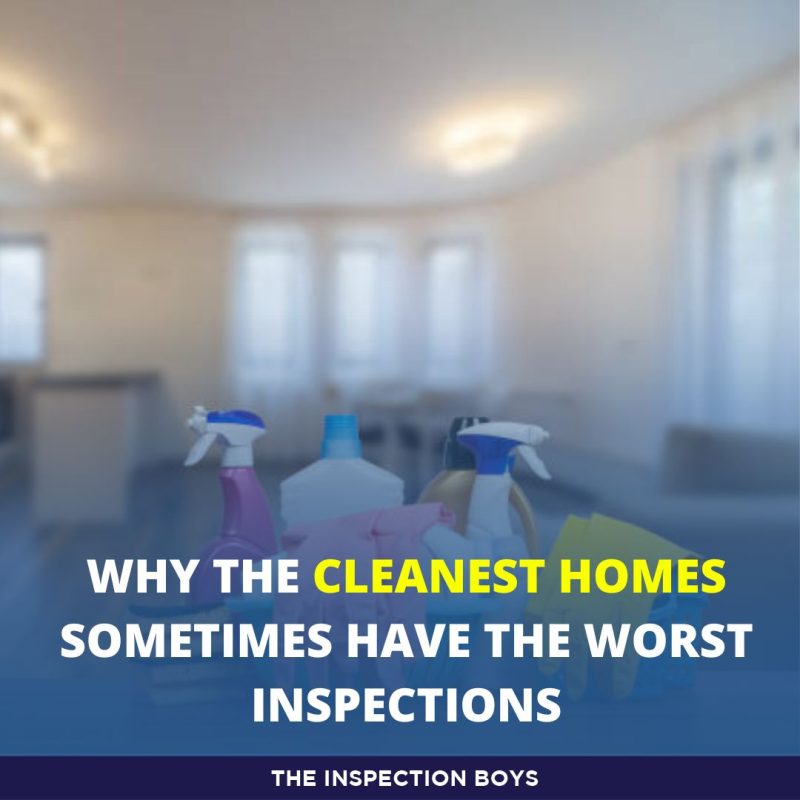You walk into a house and everything gleams. The hardwood floors shine like a showroom. The countertops look untouched. The air smells like fresh linen. It feels like a no-brainer. Surely, a home that spotless must be well cared for, right?
Not necessarily.
Homebuyers often assume that a clean house equals a well-maintained house. And while cleanliness can reflect pride of ownership, it can also distract from deeper issues. Some of the most beautiful listings have produced surprisingly rough inspection reports. It’s not because someone is trying to trick you (though that does happen). It’s because good maintenance isn’t always visible.
Clean Doesn’t Mean Cared For
One of the most common misconceptions in real estate is that visual appeal correlates with mechanical soundness. A spotless home may signal attention to detail, but it doesn’t guarantee what’s happening behind the walls or under the house.
Sellers who deep clean and stage their homes well know that first impressions matter. That’s smart. But new paint can hide old stains. Scents can mask musty smells. Decorative rugs might be covering a soft spot in the floor. These aren’t necessarily signs of deception. Sometimes sellers genuinely don’t know about deeper issues themselves.
A home inspector doesn’t look for beauty. They look for function, safety, and durability. Their job is to find what you can’t see during a casual walkthrough. And in many cases, what’s hidden turns out to be more important than what’s polished.
The Illusion of “Move-In Ready”
Real estate listings love to use the phrase “move-in ready.” And in some cases, it’s true. But in others, it just means the house has been freshly cleaned and staged. There’s nothing wrong with that. The problem is when buyers equate move-in ready with problem-free.
You might be emotionally sold on the home before the inspection even happens. That makes it harder to absorb the results of the report. Suddenly, things like outdated electrical panels or worn HVAC systems feel like betrayals.
But this isn’t about the seller hiding anything. It’s about our own tendency to be blinded by a tidy package. Move-in ready should mean you can live in it comfortably from day one. It shouldn’t mean you skip due diligence.
The Most Common Hidden Problems
Even the most immaculate homes can have serious underlying issues. Here are a few that frequently show up during inspections:
- Roof problems: You can’t see the state of the roof from the living room, no matter how nice the furniture is.
- Foundation issues: These are often invisible unless you’re in the crawlspace or basement. Cracks, moisture, and settling aren’t easy to spot casually.
- Plumbing wear: That beautiful kitchen faucet may hide aging pipes or subpar water pressure.
- Electrical concerns: New light fixtures don’t mean the wiring behind them is up to code.
- HVAC systems: Shiny vents don’t reveal whether the furnace has been serviced or the AC is nearing the end of its life.
In short, inspectors aren’t impressed by decor. They’re looking at bones, systems, and history.
Why Sellers Might Not Know Either
It’s easy to assume that a seller should be aware of every issue in their house. But many homeowners don’t spend much time in the attic, crawlspace, or on the roof. If everything looks and feels fine, they may have no reason to think otherwise.
That’s why pre-inspections can be useful, especially for older homes. But not all sellers go that route. And even if they did, some choose not to disclose minor issues if they think it will complicate the sale.
This isn’t always dishonest. Sometimes it’s just human nature. People live around problems without noticing them all the time. As a buyer, that’s why you need your own professional eyes on the property.
Emotional Attachment Can Cloud Judgment
When a home looks perfect, buyers get attached fast. That emotional response is natural, but it can make it harder to hear what the inspection report says.
Suddenly, a list of concerns can feel like an attack on something you already pictured as your future. It’s not. It’s just data. Inspections aren’t there to crush dreams. They’re there to protect your future self from expensive surprises.
If you can separate your feelings from the facts, you’ll be in a better position to decide what really matters and what can be dealt with over time.
What to Do When the Report Surprises You
So you got the report back, and it doesn’t match the vibe of the house you toured. What now?
First, don’t panic. It’s rare to find a truly “perfect” home. The question isn’t whether issues exist, but whether they’re manageable.
Work with your agent and inspector to sort the findings into three buckets:
- Immediate safety or structural concerns
- Maintenance or medium-term repairs
- Minor issues or cosmetic quirks
From there, you can decide what’s worth negotiating, what you can live with, and what might be a dealbreaker. Just remember that the presence of problems doesn’t necessarily mean the home is a bad buy. It just means you’re seeing the whole picture.
When Clean Does Matter
Let’s be clear: cleanliness isn’t irrelevant. A clean, well-kept home does say something about how it’s been treated. A dirty, neglected one can signal bigger issues or deferred maintenance. But clean is just a surface layer. It should prompt a closer look, not a blind leap.
What you want is alignment: a home that looks good, feels right, and performs well under inspection. That combination is out there. But it takes discipline to look past first impressions and let the facts speak for themselves.
In real estate, what you don’t see often matters just as much as what you do. And the cleanest homes? Sometimes they need the most attention once the sparkle fades.

